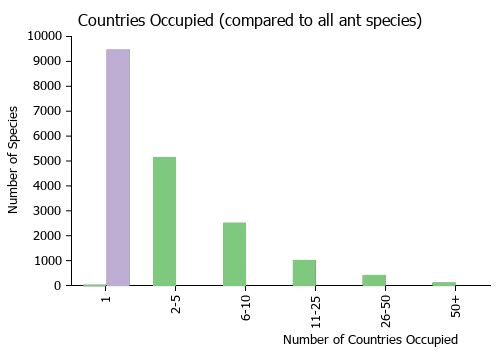Strumigenys stenotes
| Strumigenys stenotes | |
|---|---|

| |
| Scientific classification | |
| Kingdom: | Animalia |
| Phylum: | Arthropoda |
| Class: | Insecta |
| Order: | Hymenoptera |
| Family: | Formicidae |
| Subfamily: | Myrmicinae |
| Tribe: | Attini |
| Genus: | Strumigenys |
| Species: | S. stenotes |
| Binomial name | |
| Strumigenys stenotes (Bolton, 2000) | |
The only non-type collection of this species was found in a forest litter-sample.
Identification
Bolton (2000) - A member of the crassicornis complex in the Strumigenys gundlachi group. At first glance stenotes appears as a larger, more stockily built version of Strumigenys zeteki, and indeed the two are very close. However, the size difference is very obvious, the outer margin of the mandible is not distinctly concave in stenotes and the mandible generally has fewer denticles. For general description of head, body and pilosity see under zeteki.
Keys including this Species
Distribution
Latitudinal Distribution Pattern
Latitudinal Range: 5.236944444° to -14.742222°.
| North Temperate |
North Subtropical |
Tropical | South Subtropical |
South Temperate |
- Source: AntMaps
Distribution based on Regional Taxon Lists
Neotropical Region: Brazil (type locality).
Distribution based on AntMaps
Distribution based on AntWeb specimens
Check data from AntWeb
Countries Occupied
| Number of countries occupied by this species based on AntWiki Regional Taxon Lists. In general, fewer countries occupied indicates a narrower range, while more countries indicates a more widespread species. |

|
Estimated Abundance
| Relative abundance based on number of AntMaps records per species (this species within the purple bar). Fewer records (to the left) indicates a less abundant/encountered species while more records (to the right) indicates more abundant/encountered species. |

|
Biology
Castes
Nomenclature
The following information is derived from Barry Bolton's Online Catalogue of the Ants of the World.
- stenotes. Pyramica stenotes Bolton, 2000: 192 (w.) BRAZIL. Combination in Strumigenys: Baroni Urbani & De Andrade, 2007: 128
Unless otherwise noted the text for the remainder of this section is reported from the publication that includes the original description.
Description
Worker
HOLOTYPE. TL 2.3, HL 0.63, HW 0.43, CI 68, ML 0.24, MI 38, SL 0.24, SI 56, PW 0.31, AL 0.60. Characters of crassicornis complex. Apicodorsal tooth of mandible in full-face view distinctly hooked posteriorly. Proximal of apicodorsal tooth with 4 - 5 minute denticles and a much larger submedian tooth that is weakly sloped posteriorly. Proximal to submedian tooth is a row of 3 - 4 minute denticles that terminates at about the basal quarter. Apex of mandible with 4 intercalary denticles between apicodorsal and apicoventral teeth. Outer margin of mandible not obviously concave through its median third. Head markedly flattened, in profile the maximum vertical distance between highest and lowest points of head capsule is 0.35 - 0.40 X HL.
PARATYPE. TL 2.2, HL 0.61-0.62, HW 0.41-0.42, CI 66-69, ML 0.23-0.24, MI 37-39, SL 0.24, SI 57-58, PW 0.28-0.30, AL 0.58-0.60 (2 measured).
Type Material
Holotype worker, Brazil: Amazonas, Manaus, km. 41, 6.ii.1994, #161 (R. Didham) (The Natural History Museum).
Paratypes. 2 workers with same data as holotype; 1 worker, Brazil: Arnapa, Macapa, Rod. Duque de Caixas, km. 9, 19.x.1997, 20L (J. M. Vilhena) (BMNH, Museum of Comparative Zoology, Instituto Nacional de Pesquisas da Amazonia).
References
- Baroni Urbani, C. & De Andrade, M.L. 2007. The ant tribe Dacetini: limits and constituent genera, with descriptions of new species. Annali del Museo Civico di Storia Naturale “G. Doria” 99:1-191.
- Bolton, B. 2000. The ant tribe Dacetini. Memoirs of the American Entomological Institute. 65:1-1028. (page 192, worker described)
- [[Media:Silva, T.S.R.D., Chaul, J.C.M. et al. 2022. Lectotype designation and redescription of four commonly collected Neotropical species of Strumigenys (10.5852@ejt.2022.798.1673).pdf|Silva, T.S.R.D., Chaul, J.C.M., Feitosa, R.M. 2022. Lectotype designation and redescription of four commonly collected Neotropical species of Strumigenys (Hymenoptera: Formicidae). European Journal of Taxonomy, 798(1), 103–126 (Template:Doi.org).]]
References based on Global Ant Biodiversity Informatics
- Alonso L. E., J. Persaud, and A. Williams. 2016. Biodiversity assessment survey of the south Rupununi Savannah, Guyana. BAT Survey Report No.1, 306 pages.

